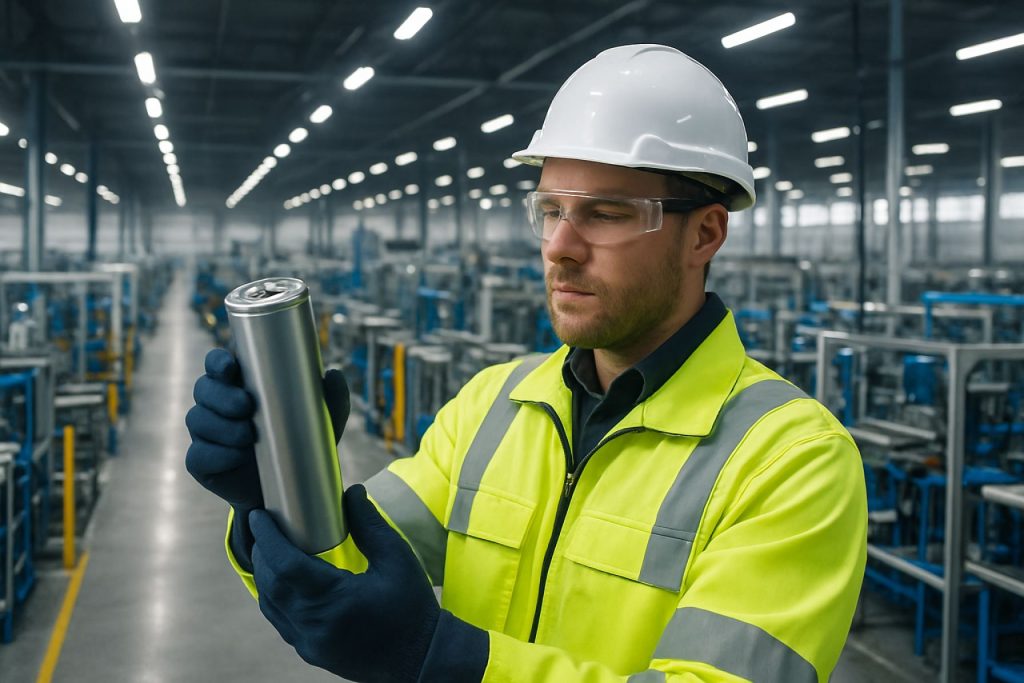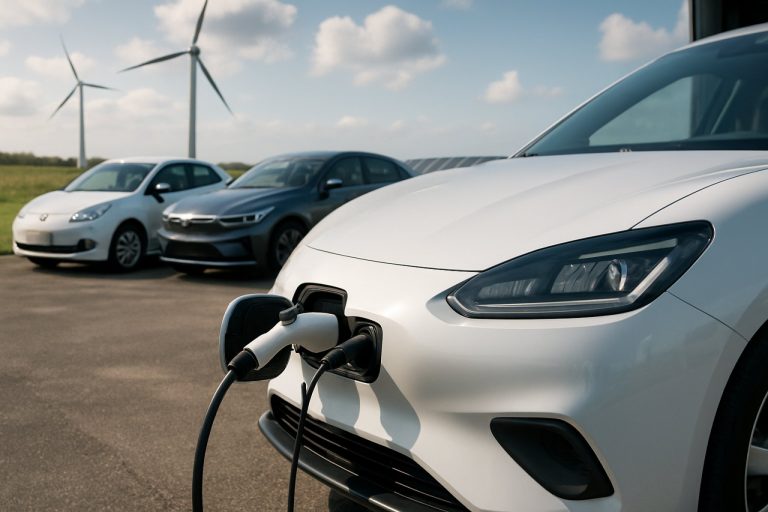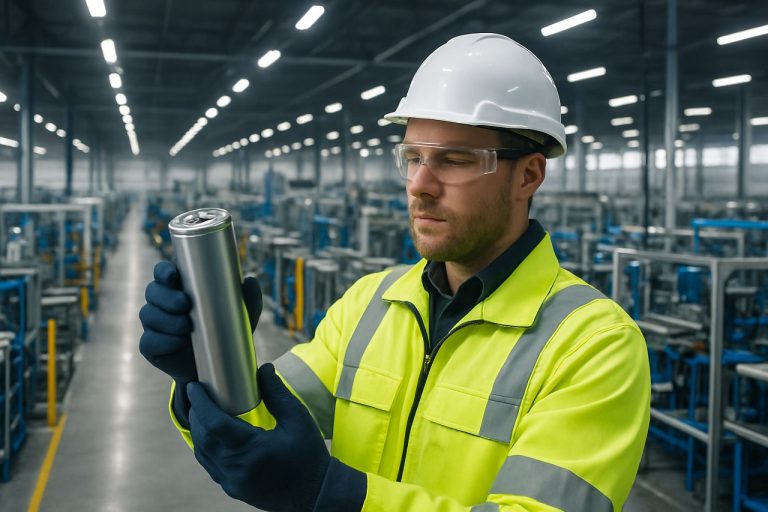
Inside the Battery Gigafactory Boom: How 2025 Will Redefine Energy Storage and Electrify Global Supply Chains. Explore the Technologies, Investments, and Market Forces Driving a New Industrial Revolution.
- Executive Summary: The Gigafactory Revolution in 2025
- Global Market Forecast: 2025–2030 Growth Trajectory
- Key Players and New Entrants: Company Strategies and Expansions
- Technological Innovations: Next-Gen Battery Chemistries and Manufacturing
- Supply Chain Dynamics: Raw Materials, Sourcing, and Sustainability
- Regional Hotspots: Asia, Europe, and North America’s Race for Capacity
- Policy, Regulation, and Incentives: Governmental Impact on Gigafactories
- Investment Trends: Capital Flows, M&A, and Strategic Partnerships
- Challenges and Risks: Environmental, Logistical, and Geopolitical Factors
- Future Outlook: Scaling to Terafactories and the Road to 2030
- Sources & References
Executive Summary: The Gigafactory Revolution in 2025
The global battery gigafactory landscape is undergoing a transformative expansion in 2025, driven by surging demand for electric vehicles (EVs), grid-scale energy storage, and the broader electrification of industry. Gigafactories—large-scale battery manufacturing plants—are now central to national industrial strategies, supply chain security, and the race to decarbonize transportation and power sectors.
By 2025, the number of operational and announced gigafactories worldwide is projected to exceed 400, with a combined annual production capacity surpassing 6 TWh. This marks a dramatic increase from just a handful of such facilities a decade earlier. The largest concentration of gigafactories remains in China, where companies like Contemporary Amperex Technology Co. Limited (CATL) and EVE Energy are scaling up to maintain global leadership. CATL alone is expected to reach over 500 GWh of annual capacity by 2025, supplying major automakers and energy storage projects worldwide.
Europe is rapidly closing the gap, with significant investments from both established battery players and new entrants. Northvolt is ramping up production at its Swedish gigafactory, targeting 60 GWh annual output, while LG Energy Solution and Samsung SDI are expanding their European footprints. The European Union’s Battery Alliance initiative continues to foster regional supply chains and technology development, aiming to reduce reliance on Asian imports.
In the United States, the Inflation Reduction Act and other policy incentives have catalyzed a wave of gigafactory announcements and construction. Tesla is expanding its Nevada and Texas gigafactories, while Panasonic, General Motors (with Ultium Cells), and Ford Motor Company (with BlueOval SK) are investing billions in new facilities. These projects are designed to secure domestic battery supply for the rapidly growing North American EV market and to meet stringent local content requirements.
Looking ahead, the gigafactory revolution is expected to intensify competition for raw materials, talent, and technological innovation. Companies are increasingly focused on vertical integration, recycling, and next-generation chemistries to ensure sustainability and cost competitiveness. As gigafactories become the backbone of the clean energy transition, their success will be pivotal in shaping the global industrial landscape through the remainder of the decade.
Global Market Forecast: 2025–2030 Growth Trajectory
The global battery gigafactory landscape is poised for rapid expansion between 2025 and 2030, driven by surging demand for electric vehicles (EVs), grid-scale energy storage, and the ongoing transition to renewable energy. By 2025, global lithium-ion battery manufacturing capacity is projected to exceed 2,500 GWh, with over 300 gigafactories either operational or under construction worldwide. This marks a dramatic increase from less than 1,000 GWh in 2021, reflecting aggressive investment and policy support across major economies.
Asia remains the epicenter of battery production, with Contemporary Amperex Technology Co. Limited (CATL) and LG Energy Solution leading global capacity. CATL, the world’s largest battery manufacturer, is expanding its footprint in China and Europe, targeting over 500 GWh annual capacity by 2025. LG Energy Solution, based in South Korea, is scaling up its global network, including new plants in the United States and Europe, aiming for more than 300 GWh by mid-decade. Panasonic Holdings Corporation and Samsung SDI are also investing heavily in next-generation cell technologies and new gigafactories.
Europe is rapidly closing the gap, with the European Union’s “Battery Alliance” fostering a regional supply chain. Northvolt AB is a flagship European player, with its Swedish gigafactory targeting 60 GWh by 2025 and further expansion planned. Other major European projects include Automotive Cells Company (ACC)—a joint venture between Stellantis, Mercedes-Benz, and TotalEnergies—and Verkor, both aiming to supply the continent’s automakers with locally produced cells.
In North America, the United States is accelerating domestic battery manufacturing to reduce reliance on Asian imports. Tesla, Inc. continues to expand its Gigafactory Nevada and is ramping up new facilities in Texas and Berlin. General Motors Company and Ford Motor Company are investing billions in joint ventures with battery specialists such as SK On and LG Energy Solution, with multiple gigafactories under construction and scheduled to come online by 2025–2026.
Looking ahead to 2030, global battery manufacturing capacity is forecast to surpass 6,000 GWh, with significant growth in North America and Europe as governments incentivize local production and supply chain resilience. The next few years will see intensified competition, technological innovation (including solid-state and sodium-ion batteries), and a focus on sustainability and recycling, as gigafactories become central to the global energy transition.
Key Players and New Entrants: Company Strategies and Expansions
The global race to establish battery gigafactories is intensifying as automakers and battery manufacturers seek to secure supply chains and meet surging demand for electric vehicles (EVs) and energy storage systems. By 2025, the landscape is dominated by a mix of established giants and ambitious new entrants, each deploying distinct strategies to scale up production, localize supply, and innovate in battery technology.
Among the most prominent players, Tesla, Inc. continues to expand its gigafactory footprint. Its Gigafactory Nevada and Gigafactory Shanghai are already operational, with Gigafactory Berlin and Gigafactory Texas ramping up production. Tesla’s strategy emphasizes vertical integration, in-house cell manufacturing, and partnerships for raw materials, aiming to reduce costs and increase control over the supply chain.
Asian battery manufacturers remain pivotal. Contemporary Amperex Technology Co., Limited (CATL), the world’s largest battery producer, is aggressively expanding outside China, with new gigafactories under construction in Germany and Hungary. CATL’s approach combines large-scale investments, joint ventures with automakers, and a focus on lithium iron phosphate (LFP) and next-generation chemistries. LG Energy Solution and Samsung SDI are also scaling up, particularly in North America and Europe, often through joint ventures with automakers such as General Motors and Stellantis.
European initiatives are gaining momentum, driven by the EU’s push for battery sovereignty. Northvolt AB, a Swedish startup, is a leading new entrant, with its Northvolt Ett gigafactory in Sweden targeting 60 GWh annual capacity by the mid-2020s. Northvolt’s strategy centers on sustainable production, recycling, and partnerships with European automakers like Volkswagen and BMW. Other European projects include Automotive Cells Company (ACC), a joint venture between Stellantis, Mercedes-Benz, and TotalEnergies, which is building gigafactories in France, Germany, and Italy.
In the United States, Panasonic Holdings Corporation is expanding its partnership with Tesla and constructing new facilities in Kansas and Nevada. Ford Motor Company and General Motors Company are investing billions in joint ventures with battery specialists to localize cell production and secure supply for their EV lineups.
Looking ahead to 2025 and beyond, the sector is expected to see further capacity announcements, increased localization of supply chains, and a wave of new entrants leveraging advanced chemistries and recycling. The competitive landscape will be shaped by the ability to scale rapidly, secure raw materials, and innovate in both technology and sustainability.
Technological Innovations: Next-Gen Battery Chemistries and Manufacturing
Battery gigafactories are at the forefront of the global transition to electrification, with 2025 marking a pivotal year for technological innovation and manufacturing scale-up. These massive facilities, often exceeding several gigawatt-hours (GWh) in annual output, are not only expanding in number but also rapidly integrating next-generation battery chemistries and advanced production techniques.
A key trend in 2025 is the shift toward lithium iron phosphate (LFP) and high-nickel chemistries, driven by the need for cost reduction, safety, and higher energy density. Contemporary Amperex Technology Co., Limited (CATL), the world’s largest battery manufacturer, is scaling up LFP production in its new and existing gigafactories, while also advancing its “Qilin” cell-to-pack technology for improved volumetric efficiency. LG Energy Solution and Panasonic Holdings Corporation are investing in high-nickel NCM (nickel-cobalt-manganese) and NCA (nickel-cobalt-aluminum) chemistries, targeting longer-range electric vehicles and grid storage.
Solid-state batteries, long considered the “holy grail” of energy storage, are moving closer to commercial reality. Toyota Motor Corporation has announced plans to begin pilot production of solid-state batteries in 2025, aiming for higher energy density and faster charging. Samsung SDI is also progressing with solid-state prototypes, with gigafactory-scale manufacturing targeted for the latter half of the decade.
Manufacturing innovation is equally critical. Automation, artificial intelligence, and digital twins are being deployed to optimize yield, reduce defects, and accelerate scale-up. Tesla, Inc. continues to refine its “dry electrode” process at its gigafactories, which promises to lower costs and environmental impact. Northvolt AB in Sweden is pioneering closed-loop recycling within its gigafactories, integrating recovered materials directly into new cell production.
Looking ahead, the global gigafactory pipeline is set to exceed 8,000 GWh of annual capacity by 2030, with over 400 facilities announced or under construction worldwide. In 2025 and the following years, the race will intensify not only to expand capacity but also to commercialize next-gen chemistries and sustainable manufacturing practices, positioning gigafactories as the linchpin of the battery value chain and the broader energy transition.
Supply Chain Dynamics: Raw Materials, Sourcing, and Sustainability
The rapid expansion of battery gigafactories is fundamentally reshaping global supply chain dynamics, particularly in the sourcing and sustainability of raw materials. As of 2025, the proliferation of these large-scale manufacturing facilities is driven by surging demand for electric vehicles (EVs), grid storage, and consumer electronics. Major players such as Tesla, Inc., LG Energy Solution, Contemporary Amperex Technology Co., Limited (CATL), Northvolt AB, and Panasonic Corporation are leading the charge, with dozens of gigafactories under construction or ramping up production across North America, Europe, and Asia.
This rapid scaling has intensified competition for critical raw materials such as lithium, nickel, cobalt, and graphite. For instance, Tesla, Inc. has pursued direct sourcing agreements with mining companies and is investing in lithium refining capacity in the United States to secure its supply chain and reduce reliance on imports. Similarly, CATL and LG Energy Solution are forging long-term contracts with global mining firms and exploring vertical integration to mitigate supply risks and price volatility.
Sustainability is becoming a central pillar of gigafactory supply chains. Companies like Northvolt AB are emphasizing closed-loop recycling and the use of renewable energy in their manufacturing processes. Northvolt’s Swedish gigafactory, for example, is powered primarily by hydroelectricity and aims to source 50% of its raw materials from recycled batteries by the end of the decade. Panasonic Corporation and LG Energy Solution are also investing in battery recycling initiatives and collaborating with partners to develop more sustainable cathode and anode materials.
Geopolitical considerations are increasingly influencing sourcing strategies. The United States and European Union are implementing policies to localize battery supply chains and reduce dependence on imports from Asia, particularly China. The U.S. Inflation Reduction Act and the EU’s Critical Raw Materials Act are incentivizing domestic mining, processing, and recycling, prompting gigafactory operators to diversify suppliers and invest in regional ecosystems.
Looking ahead, the next few years will see continued pressure on raw material supply chains as gigafactory capacity is projected to more than double by 2030. Companies are expected to accelerate investments in sustainable sourcing, recycling technologies, and alternative chemistries to address environmental concerns and regulatory requirements. The evolution of these supply chain dynamics will be critical in determining the pace and sustainability of the global battery industry’s growth.
Regional Hotspots: Asia, Europe, and North America’s Race for Capacity
The global race to build battery gigafactories is intensifying, with Asia, Europe, and North America emerging as the primary regional hotspots. As of 2025, these regions are not only expanding their manufacturing footprints but also competing for technological leadership, supply chain security, and market share in the rapidly growing electric vehicle (EV) and energy storage sectors.
Asia—particularly China, South Korea, and Japan—continues to dominate global battery cell production. China alone accounts for over 70% of global lithium-ion battery manufacturing capacity, with major players such as Contemporary Amperex Technology Co. Limited (CATL), EVE Energy, and BYD Company Limited leading the charge. CATL, the world’s largest battery manufacturer, is expanding its domestic and overseas gigafactories, including new plants in Germany and Hungary. South Korea’s LG Energy Solution and SK On are also scaling up, with significant investments in both Asia and abroad.
Europe is rapidly closing the gap, driven by ambitious climate targets and the need for regional supply chain resilience. The European Union’s push for local battery production has spurred a wave of gigafactory announcements and construction. Northvolt AB, headquartered in Sweden, is a flagship example, with its Northvolt Ett facility ramping up production and additional plants planned in Germany and Poland. Automotive giants such as Volkswagen AG and Stellantis N.V. are investing in joint ventures and dedicated battery plants across the continent. By 2025, Europe is expected to host over 20 gigafactories, with a projected annual capacity exceeding 600 GWh.
North America is accelerating its efforts, spurred by policy incentives and the strategic imperative to localize battery supply chains. The United States is witnessing a surge in gigafactory projects, led by Tesla, Inc. with its Gigafactory Nevada and Texas, and new facilities under construction in partnership with Panasonic Holdings Corporation. General Motors Company and Ford Motor Company are collaborating with LG Energy Solution and SK On to build large-scale plants in Michigan, Tennessee, and Kentucky. Canada is also entering the fray, with Umicore and Stellantis N.V. investing in new battery and cathode material facilities.
Looking ahead, the period from 2025 onward will see these regions vying for leadership not only in capacity but also in next-generation battery technologies, sustainability, and supply chain integration. The outcome of this race will shape the global EV and energy storage landscape for years to come.
Policy, Regulation, and Incentives: Governmental Impact on Gigafactories
Government policy, regulation, and incentives are playing a pivotal role in shaping the global landscape of battery gigafactories in 2025 and the coming years. As nations race to secure supply chains for electric vehicles (EVs) and renewable energy storage, targeted governmental actions are accelerating gigafactory investments, influencing site selection, and driving technological innovation.
In the United States, the Inflation Reduction Act (IRA) of 2022 continues to have a profound impact in 2025, offering substantial tax credits and direct incentives for domestic battery manufacturing and critical mineral processing. These measures have catalyzed a surge in gigafactory announcements and construction, with major players such as Tesla, Inc., LG Energy Solution, Panasonic Holdings Corporation, and General Motors Company expanding or building new facilities across the country. The IRA’s requirements for North American sourcing of battery components and minerals are also influencing supply chain localization and partnerships with domestic mining and processing firms.
The European Union is similarly advancing its battery industry through the European Battery Alliance and the implementation of the EU Battery Regulation, which came into force in 2023. This regulation sets stringent sustainability, recycling, and due diligence requirements for batteries placed on the EU market, directly impacting gigafactory design and operations. Member states are providing financial support and streamlined permitting for projects that align with these goals. Companies such as Northvolt AB and Automotive Cells Company (ACC) are among the beneficiaries, with multiple gigafactories under construction or expansion in Sweden, Germany, and France.
In Asia, China remains the global leader in battery manufacturing capacity, supported by long-standing industrial policies, subsidies, and export incentives. Companies like Contemporary Amperex Technology Co., Limited (CATL) and BYD Company Limited continue to expand both domestically and internationally, leveraging government-backed financing and favorable regulatory environments. Meanwhile, South Korea and Japan are bolstering their own battery sectors through R&D incentives and support for overseas gigafactory investments by firms such as Samsung SDI Co., Ltd. and Panasonic Holdings Corporation.
Looking ahead, the interplay of policy, regulation, and incentives will remain a decisive factor in gigafactory deployment. Governments are expected to further tighten sustainability standards, increase local content requirements, and expand financial support to ensure energy security and competitiveness in the rapidly evolving battery sector.
Investment Trends: Capital Flows, M&A, and Strategic Partnerships
The battery gigafactory sector is experiencing unprecedented investment momentum as global demand for electric vehicles (EVs), energy storage systems, and renewable integration accelerates. In 2025 and the coming years, capital flows are being driven by both established battery manufacturers and new entrants, with a focus on scaling up production capacity, securing supply chains, and advancing next-generation technologies.
Major industry players are committing tens of billions of dollars to new and expanded gigafactory projects. Contemporary Amperex Technology Co., Limited (CATL), the world’s largest battery producer, continues to expand its global footprint with new facilities in China, Europe, and North America. LG Energy Solution and Panasonic Corporation are similarly investing heavily in new plants and capacity upgrades, often in partnership with automakers. For example, LG Energy Solution has announced joint ventures with General Motors and Honda Motor Co., Ltd. to build gigafactories in the United States, targeting a combined annual capacity of over 100 GWh by the late 2020s.
Strategic partnerships and joint ventures are a defining feature of the current investment landscape. Automakers are increasingly entering direct partnerships with battery manufacturers to secure long-term supply and co-develop advanced chemistries. Tesla, Inc. continues to expand its own gigafactory network, including the Gigafactory Texas and Gigafactory Berlin, while deepening collaborations with suppliers such as Panasonic Corporation and CATL. Meanwhile, Northvolt AB is scaling up its European operations with support from automotive partners like Volkswagen AG and BMW Group.
Mergers and acquisitions (M&A) activity is also intensifying as companies seek to consolidate expertise, access new markets, and secure raw material sources. Notable recent deals include Ford Motor Company’s investment in battery technology startups and Stellantis N.V.’s acquisition of stakes in battery joint ventures. Additionally, upstream investments in mining and refining by battery manufacturers and automakers are becoming more common, reflecting the strategic importance of raw material security.
Looking ahead, the outlook for battery gigafactory investment remains robust. Industry forecasts suggest global battery manufacturing capacity could exceed 6 TWh by 2030, with the majority of new capacity coming online between 2025 and 2028. This rapid expansion is expected to be underpinned by continued capital inflows, cross-sector partnerships, and a wave of technological innovation, positioning gigafactories as central nodes in the future energy and mobility landscape.
Challenges and Risks: Environmental, Logistical, and Geopolitical Factors
The rapid expansion of battery gigafactories worldwide is central to the electrification of transport and the transition to renewable energy. However, this growth brings significant challenges and risks across environmental, logistical, and geopolitical dimensions, which are expected to intensify through 2025 and the following years.
Environmental Concerns: The environmental footprint of gigafactories is under increasing scrutiny. Battery production is energy-intensive, with substantial greenhouse gas emissions if powered by fossil fuels. Water usage is another concern, especially in regions facing scarcity. Additionally, the extraction and processing of critical minerals such as lithium, cobalt, and nickel can result in habitat destruction, pollution, and social disruption. Leading manufacturers like Tesla, Inc. and Contemporary Amperex Technology Co., Limited (CATL) have announced initiatives to reduce emissions and increase recycling, but the scale of new facilities may outpace these efforts in the near term.
Logistical and Supply Chain Risks: The battery supply chain is complex and global, making gigafactories vulnerable to disruptions. The COVID-19 pandemic and recent geopolitical tensions have exposed weaknesses in sourcing raw materials and components. For example, LG Energy Solution and Panasonic Corporation have both reported delays and cost increases due to shortages of key materials and transportation bottlenecks. As demand for electric vehicles and stationary storage surges, competition for minerals is expected to intensify, potentially leading to further price volatility and supply insecurity.
Geopolitical Factors: The concentration of mineral resources and processing capacity in a few countries, notably China, poses strategic risks. Governments in the United States, European Union, and elsewhere are responding with policies to localize battery manufacturing and secure supply chains. For instance, Northvolt AB is building large-scale facilities in Sweden and Germany, aiming to reduce European dependence on Asian suppliers. However, these efforts require time and significant investment, and may be challenged by trade disputes, export restrictions, or shifting alliances.
Looking ahead to 2025 and beyond, the battery gigafactory sector faces a delicate balancing act: scaling up production to meet climate goals while managing environmental impacts, supply chain vulnerabilities, and geopolitical uncertainties. The ability of industry leaders and policymakers to address these challenges will shape the pace and sustainability of the global energy transition.
Future Outlook: Scaling to Terafactories and the Road to 2030
The global battery gigafactory landscape is entering a pivotal phase in 2025, as the industry accelerates toward terawatt-hour (TWh) scale production to meet surging demand from electric vehicles (EVs), grid storage, and industrial applications. The transition from gigafactories—typically defined as facilities with annual output in the tens of gigawatt-hours (GWh)—to so-called “terafactories” is now a central focus for leading battery manufacturers and automakers.
By 2025, the cumulative global battery manufacturing capacity is projected to surpass 2 TWh per year, with over 300 gigafactories announced or under construction worldwide. This rapid expansion is led by established players such as Contemporary Amperex Technology Co., Limited (CATL), the world’s largest battery producer, which is scaling multiple sites in China and Europe, and LG Energy Solution, which is expanding its footprint in South Korea, the United States, and Poland. Panasonic Holdings Corporation continues to invest in its North American operations, notably in partnership with Tesla, Inc. at the Nevada Gigafactory, while Samsung SDI Co., Ltd. and SK On Co., Ltd. are also ramping up capacity in both Asia and the West.
In Europe, the push for battery sovereignty is driving significant investment. Northvolt AB is scaling its Swedish gigafactory, targeting 60 GWh annual output by the mid-2020s, and has announced plans for additional sites in Germany. Meanwhile, Automotive Cells Company (ACC)—a joint venture between Stellantis, Mercedes-Benz, and TotalEnergies—is constructing multiple gigafactories in France, Germany, and Italy, aiming for a combined capacity exceeding 120 GWh by 2030.
The United States is witnessing a surge in domestic battery manufacturing, spurred by policy incentives and the Inflation Reduction Act. General Motors Company and Ford Motor Company are investing billions in joint ventures with battery specialists such as Ultium Cells LLC and BlueOval SK. FREYR Battery and Envision AESC Group Ltd. are also establishing large-scale plants in the U.S. and Europe.
Looking ahead, the industry’s trajectory points toward the emergence of terafactories—facilities with annual output of 100 GWh or more, and ultimately, multi-hundred GWh scale. Tesla, Inc. has publicly stated ambitions to reach several TWh of annual battery production by 2030, with its Texas and Berlin gigafactories serving as blueprints for future expansion. Similarly, CATL and LG Energy Solution are planning next-generation plants with modular, highly automated production lines to achieve economies of scale and reduce costs.
The next few years will be defined by the race to scale, technological innovation in cell chemistry and manufacturing, and the localization of supply chains. As gigafactories evolve into terafactories, the battery industry is poised to become a cornerstone of the global energy transition, with 2025 marking a critical inflection point on the road to 2030.
Sources & References
- Contemporary Amperex Technology Co. Limited (CATL)
- EVE Energy
- Northvolt
- General Motors
- Automotive Cells Company (ACC)
- Verkor
- Toyota Motor Corporation
- BYD Company Limited
- Volkswagen AG
- Stellantis N.V.
- Umicore



